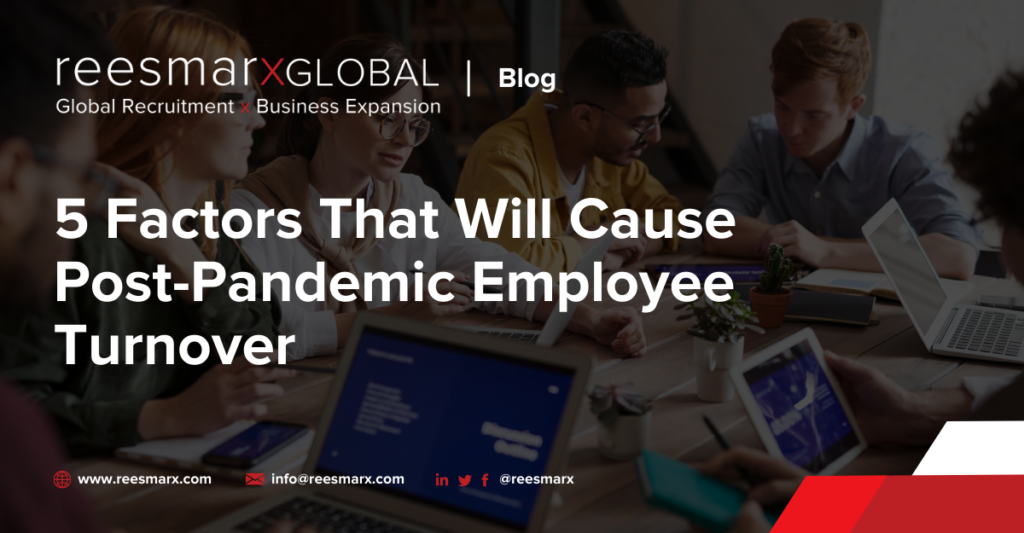The transition to a full staff on premises may be a slow one for businesses in many countries. While organizations are evaluating strategies to bring some of their team back to work in-office, the Covid-19 health crisis makes long-term planning difficult. Shutdowns are still the first defense in controlling infection rates, and that can bring a reversal of plans to return employees to the office.
While unemployment rates in many major markets remain high, there has been an important shift in work culture that may present new challenged. Human resource analysts are predicting a mass turnover of employees, post-pandemic. And there are five factors that will contribute to recruitment and retention difficulties for businesses.
1. More Professionals Seek Full-Time Work-From-Home
As the world moves ahead on a path to vaccination, there is an urgent hope of getting the Covid-19 virus under control. However, as new variants of the virus are being discovered, some health experts have suggested that we may be coping with the virulent coronavirus for several more years.
Businesses have adjusted to the emergency pivot to allow employees to work from home. And so have employees.Professionals who have never worked from home before, are now equipped to do so.They have established their home office and learned that they are very capable of productive remote work.
There are many reasons and studies that support work from home (WFH) as beneficial to employers and employees.Professionals in some cases, have more than one year of experience working remotely.And while pandemic burnout is a factor, employees have realized the benefits of working from home.
The main reasons why professionals prefer to work from home are:
- Cost savings. They are spending less on travel, snacks and meals, and other expenses associated with working in-office.
- Time savings. Professionals who had a long or multiple mode of transportation commute, have eliminated travel time from their day.And feel more productive and less fatigued as a result.
- Ease of childcare. It is not easy trying to work from home when you have children in the house. Parents have been struggling during phases where home schooling was required for social distancing. But after almost 1.5 years of figuring out a new work and life schedule, many have mastered it. Parents enjoy the ability to spending more time with their children rather than rushing out the door or having a childcare professional assist with before and after school transportation.
- Fewer distractions. Connecting with co-workers in an office was thought to provide team building and collaborative value.Software like Microsoft Teams and Zoom have been seamlessly integrated into the workday.Instant messaging software through Salesforce or SLACK have made communications between remote workers easy and efficient.Many studies suggest that working from home is more productive and less stress for employees.
Individuals who are working from home currently, will be asked to return to the office.And human resource experts are anticipating a large number will leave their current employer as a result. And seek new opportunities to work full-time and permanently from home.
Employers who do not offer remote work accommodations may find a problem recruiting talent.And they may also experience tremendous difficulties retaining experienced team members.Employees tried remote work, they liked it, they were good at it, and they don’t want the ‘old normal’ back.It could become a major recruitment issue in 2021 through 2022 for businesses.
2. Psychological Burnout Causes Re-Evaluation of Work and Life Balance
Around the world, people are evaluating many aspects of their professional, personal and financial needs.Some people remained employed by their company, as other employees were laid off, or dismissed.Many companies contracted their workforce during the pandemic as a cost-saving strategy to cope with the unexpected economic adversities.
But that may also have created an overload of workflow and responsibilities for the employees that did retain their job within the organization.Employees were (and still are) unlikely to complain about taking on more responsibility, with fewer team members remaining.Job insecurity has been at an all-time high.
Remote workers are also putting in far more time at their desk, than they did at the workplace. A recent survey of 3.1 million American employees confirmed the trend of longer works hours. Job insecurity is cited as the main reason for the voluntary overtime that is contributing to professional burnout.
The average in the survey from Harvard Business School, co-authored by Jeffrey Polzer (Professor) found employees were contributing an average of 48.5 minutes more per day.That is approximately four (4) extra unpaid hours per week. But many feel the number is not representative of the true trends, including employees who may be working seven (7) days a week.
3. Mass Exodus of Female Professionals from the Workforce
In the United States alone, more than two million women employed, exited the workforce.As the pandemic impacted caretaking for children, seniors and loved ones who fell ill, women took up the mantle of familial care at home.
In relationships where caretaking was evenly divided between two partners, women were less likely to reduce their work hours or leave the workforce.A new article in Fortune explains what led to the crisis, and how it has impacted the financial stability of many households. Forcing a return to one-income, and difficulties.
The longer the pandemic persists, the greater the impact of unemployment on female professionals. Not only that, but women who take an absence from their career for several years, may require retraining to enter the workforce again. Particularly if they are employed in the STEM sectors.
4. Adjusting Cost of Living and Relocating Out of Metropolitan Centers
For the first time in more than 100 years, there is a higher vacancy rate in New York City.Rents are notoriously high, and the waiting list for residential rental properties has always been a challenge.But during the height of the pandemic, New York City actually saw a significant decline in population.And the cost of housing has also gone done, as a result of lower demand.
That is just one example of a geographic shift.People who are able to work full-time from home, don’t need to live in a metropolitan center.And many have migrated to the suburbs to work remotely, and to see relief from traditionally high rent rates.Purchasing a home in most markets, is less expensive than renting in a city center.The economic impact of the Covid-19 pandemic has made professionals rethink where and how they work.And the mass adoption of remote work has allowed people to live in less expensive rural areas, while still making an urban level income.
This also means that employers based in metropolitan areas may find it harder to recruit and retain talent. Which is normally never a problem for businesses located in populous cities.
5. The Search for Better Health Benefits and Sick Leave Coverage
For some people, the Covid-19 virus meant a week of symptoms, but little disruption to their life or work duties.For others, the virus had devastating health effects.And may have resulted in an absence from work to recover.
Fiscal needs, income and health benefits are very much on the mind of career professionals. In the United States, health insurance is more affordable when it is employer sponsored. And not paid for 100% out of pocket by the employee. Professionals may consider finding a new job, if the current health, short and long-term disability coverage are a higher priority now.
Some employers are already anticipating this priority shift, and augmenting benefits in order to create a competitive recruitment advantage. Flexible paid time off for health and caretaking needs, are one of the most valuable benefits for top tier career professionals.
How We Can Help
For over twenty years, reesmarx has been a global leader in recruitment and human resource services. We help businesses find the top 3% of available talent in any major market.Think outside borders, when it comes to legacy planning, labor mobility and creating your competitive team.Remote professionals can be recruited to augment your team.
Our executive HR consultants can also provide additional assistance to provide new health benefits to your team.If you are planning a global business expansion, contact us to discuss setting up a PEO, for full human resource management, including recruitment and retention programs, payroll, and benefits administration.We have turnkey solutions that allow small and medium sized businesses to compete with corporations and recruit top talent.






